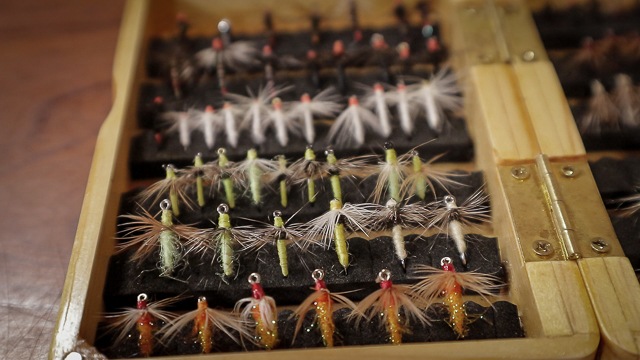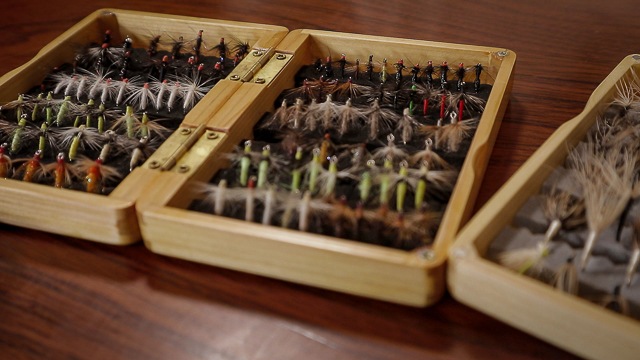Tenkara Fly Tying
Tenkara fly tying suffers from a lot of myths. You may already know all about the system for choosing and using and using simple flies explained in our book How to Fool Fish with Simple Flies. In the video episode below, you get a unique opportunity to look through a private collection of flies belonging to Kura-san – as well as learning why he varies the color of his dubbing according to the season and how he takes advantage of different hackle types for fishing different depths and different manipulations. These concepts are fascinating additions that fit right into our overall system – and the flies that Kura-san designs for his tenkara are very easy to tie yourself. Inside the Masterclass online course you’ll find an updated step-by-step tying demo video as well as detailed discussions on tactics. But first, the free episode:
Modern Tenkara Fly Tying – Tenkara in Focus Season 3 Ep3 (現代のテンカラ 毛鉤巻き)
To enrol on (or just find out more about) Kura-san’s exclusive Masterclass online course click here.
Kura-san’s Seasonal Fly Tying
In the interview above, it quickly becomes clear that there are a lot more “games” out there in Japanese tenkara than the idea of “The One Fly Approach”. That’s not to say that it is impossible to find someone who practices that approach in Japan, but at the same time it is really the minority philosophy within modern tenkara. At the same time, the seasonal tenkara fly tying that Kura-san practices is also a long way from an “Any Fly” approach. Like many cutting edge anglers, his tying focuses on creating and using patterns that meet a particular need.
Those needs are worked out based on his philosophy of starting the spring season with “young, fresh” light and bright colours – moving through to progressively darker patterns through the season. Other “needs” come from Kura-san’s intentions for his flies to have particular actions in the water. Those actions include relative sink-rate – and so that creates a way to control the depth that he decides to present those flies. On top of that, Kura-san also understands how the body and hackle materials react to his varying fly manipulation tactics and that lets him match just the right set of materials and fly shape/proportions to the presentation effect he is looking for. Check out the first leaf in his tenkara kebari box (below). These are mainly stiff hackled “Futsuu kebari” – with one or two softer-hackled “Jun Kebari” included. If those terms sound a bit weird, then there’s a guide to the types of Japanese tenkara flies here.

Notice that, as well as the color shades of kebari designed to appeal to the fish, Kura-san also includes kebari that are colored to contrast with the stream bed so that the angler can see these flies underwater (in other words, colored for the benefit of the angler’s eyes – not the fish’s eyes). The combination of prioritising “action” of the materials over any super “close copy” fly designs, the use of simple patterns, matching the length and stiffness of the hackle to specific presentation tactics and having a very flexible attitude to what are the most important functions of color are what set modern Japanese tenkara fly tying apart.
A range of Tenkara flies can be tied to match a range of conditions
Kura-san is keen to stress that the range of flies in his box at any one time represent his CURRENT experimental forms that he offers to the fish and then records their responses under the particular conditions that each pattern is designed for. Over time, the ideal (and perhaps never reached) goal is to gather enough experience of the fish’s reactions to his various patterns and presentations that he can choose the perfect fly for each occasion just by looking at the conditions.

I strongly encourage you (perhaps after spending a season or two nailing down the “one fly” or the “any fly” type approaches to tenkara) to start to experiment yourself with pairing particular kebari/fly patterns to specific presentation tactics and conditions. This is a very different philosophy of tenkara fly tying compared to a one/any fly philosophy.
Learning Kura-san’s Tenkara Skills
As mentioned in previous blog content, it has been our great good fortune to have stumbled upon (over the years in various careers, including professional biology and fly fishing guiding) a collection of abilities that allow us to break down and then teach the wide variety of tenkara skills that we encounter in Japan and around the world.
The overall result of that is we’ve been able to create a simple, digestible online course that easily transfers Kura-san’s key tactics to you.
Just Click here to find out more and enrol on the course to start using those tactics right away.
Paul
PS – If you learned anything here just now, Why not spread the love by sharing the article using the social media buttons on this page…? Thank you!

Another great lesson! You guys just keep delivering great content.
Huge thanks Jeff – it means a lot to us to know our stuff is “landing” with folks who appreciate it!
DT Guys, Another enjoyable and informative video and blog post. Appreciate the large photos of Kura-san’s kebari too. Thank you.
Thank you David – and we enjoyed poring over Kura-san’s fly box for our own selfish fishing delights! So it’s good to finally be able to share some of that more widely
Done. I am sure this will be the same high quality as all your material has been. You two rock.
David – right back at you sir!
By the way, we likely aren’t done with adding the surprise bonus material…